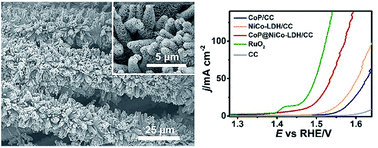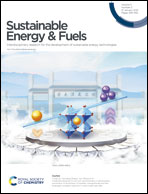A hierarchical CoP@NiCo-LDH nanoarray as an efficient and flexible catalyst electrode for the alkaline oxygen evolution reaction †
Abstract
The oxygen evolution reaction plays a vital role in lots of reproducible oxygen-based electrochemical technologies; however, suffering from intrinsically sluggish kinetics, it requires acceleration by highly-efficient water oxidation electrocatalysts. Moreover, flexible catalyst electrodes are preferable for practical technological devices. Here, we report the electrochemical deposition of ultrathin NiCo-layered double hydroxide nanosheets on a metallic CoP nanowire array directly grown on carbon cloth. The as-prepared CoP@NiCo-LDH/CC behaved efficiently as a three-dimensional (3D) flexible electrode material for catalyzing the alkaline oxygen evolution reaction. In 1.0 M KOH, affording a 20 mA cm−2 geometric catalytic current density, 87 and 52 mV overpotential reduction was observed for this CoP@NiCo-LDH/CC compared with its CoP/CC and NiCo-LDH/CC counterparts, respectively. Impressively, it also demonstrated strong durability, with its catalytic activity being maintained for at least 20 h, and a high turnover frequency value of 0.009 O2 s−1 at 360 mV overpotential.



 Please wait while we load your content...
Please wait while we load your content...